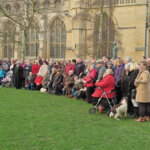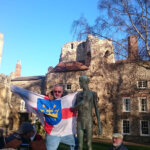The First Photo Bomb at Moyse’s Hall
We Love Bury St Edmunds is a Facebook group dedicated to celebrating the beauty and culture of the town. Recently, they launched their first-ever photo bomb campaign, which was centered around Moyse’s Hall clock. The group encouraged local residents to take photos of themselves in front of the clock, then post them to the group page. The campaign was a huge success, with hundreds of photos posted over the course of a few days.
The photos showed people of all ages and backgrounds, smiling and having fun. The campaign was a great way to capture the spirit of the town and show that there’s something special about Bury St Edmunds that makes it worth celebrating. It also brought people together and helped them connect with each other and the community. We Love Bury St Edmunds hopes to continue this momentum by hosting more campaigns in the future.
Midday 9th January 2016
- January 2016 Photo Bomb The King
Uncovering the Origins of Photo Bombing: A Look at Moyse’s Hall in Bury St Edmunds
Have you ever taken a photo, only to realize later that someone unexpected had snuck into the frame? You may have been “photo bombed.” This quirky trend has become increasingly popular in recent years, but have you ever wondered where it all began? Look no further than Moyse’s Hall in Bury St Edmunds. This historic building, dating back to 1180, has a fascinating connection to the origins of photo bombing.
I have delved into the rich history of Moyse’s Hall and uncovered some intriguing facts about this iconic location. Join me on a journey through time as we explore the surprising roots of this modern-day phenomenon. From ancient architecture to unexpected photobombers, we’ll uncover the secrets of Moyse’s Hall and discover how it has played a pivotal role in the evolution of photo bombing. So, grab your camera and let’s get started!
What is photo bombing?
Before we delve into the history of photo bombing, let’s first define what it is. A photo bomb is when someone unexpectedly enters a photo, often with the intention of being humorous or disruptive. The photo bomber may make a funny face, strike a silly pose, or simply stand in the background, creating an unexpected element in the photo. Photo bombing has become increasingly popular in recent years, with social media platforms such as Instagram and TikTok filled with countless examples. But where did this trend originate?
A brief history of Moyse’s Hall
Moyse’s Hall is a medieval building located in the heart of Bury St Edmunds, a historic market town in the county of Suffolk, England. The building dates back to 1180 and has served a variety of purposes over the centuries, including as a courthouse, a prison, and a workhouse. Today, it is a museum that showcases the history of Bury St Edmunds and the surrounding area. The building itself is a remarkable example of medieval architecture, with its timber-framed structure and distinctive gabled roof.
Moyse’s Hall has played an important role in the history of Bury St Edmunds, as it was once the town’s administrative center. It was here that officials would meet to discuss local affairs, and where criminals would be brought to stand trial. The building has survived numerous fires and renovations over the centuries, and it remains a beloved landmark in the town to this day.
Moyse’s Hall and the origins of photo bombing
So, what does Moyse’s Hall have to do with the origins of photo bombing? It turns out that the building has a long history of unexpected visitors showing up in photos. One of the earliest recorded incidents occurred in the 1800s, when a group of tourists visited Moyse’s Hall and posed for a photo in front of the building. When the photo was developed, the tourists were surprised to see that a local resident had crept into the frame, making a funny face and sticking out his tongue.
This incident may not have been the first example of photo bombing, but it is one of the earliest recorded instances, and it occurred at an iconic location that has since become synonymous with the trend. Moyse’s Hall has continued to attract unexpected photobombers over the years, with countless visitors to the museum capturing memorable moments on camera.
Famous photo bombs at Moyse’s Hall
Over the years, there have been many famous examples of photo bombs at Moyse’s Hall. One of the most well-known occurred in the 1960s, when a group of university students visited the museum on a field trip. While posing for a photo in front of the building, a local resident named Fred walked into the frame, wearing a top hat and tails and carrying a cane. The students were initially annoyed by Fred’s intrusion, but they quickly realized how funny the photo was and embraced it. The photo went on to become an iconic image of the era, and Fred himself became something of a local legend.
Tips for capturing the perfect photo bomb at Moyse’s Hall
If you’re hoping to capture the perfect photo bomb at Moyse’s Hall, there are a few tips you should keep in mind. First, be creative and have fun! Don’t be afraid to try new poses or make silly faces. The more unexpected and outrageous your photo bomb, the better. Second, be respectful of other visitors and the museum’s staff. While photo bombing can be a lot of fun, it’s important to remember that Moyse’s Hall is a public space, and everyone has a right to enjoy it. Finally, don’t be afraid to ask for help. The museum’s staff are always happy to assist with photos and can often provide creative suggestions for poses or locations.
Moyse’s Hall and the future of photo bombing
As photo bombing continues to evolve and grow in popularity, it’s likely that Moyse’s Hall will remain an iconic destination for would-be photo bombers. The building’s unique history and distinctive architecture make it a one-of-a-kind backdrop for photos, and its reputation as a spot for unexpected photobombers only adds to its appeal. As social media platforms continue to evolve, it’s likely that we’ll see even more creative and daring examples of photo bombing in the years to come.
Photo Bomb The King – The Great Churchyard
Photo Bomb The King with Anne-Marie David




